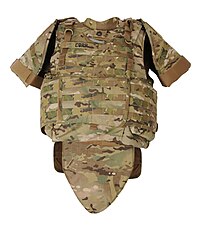
Photo from wikipedia
Abstract A comprehensive study on the impact behaviour of UHMWPE woven fabrics is presented in this paper, which consists of four parts: geometric measurement of fabric parameters, tensile testing of… Click to show full abstract
Abstract A comprehensive study on the impact behaviour of UHMWPE woven fabrics is presented in this paper, which consists of four parts: geometric measurement of fabric parameters, tensile testing of constituent yarns, impact testing of fabrics, and numerical modelling of fabrics subjected to impact loading. Two fabric materials, i.e. a plain weave fabric made of SpectraⓇ 1000 fibres and a 4-harness satin weave fabric made of DyneemaⓇ SK75 fibres, were examined. Firstly, the geometric features of fabrics, such as yarn cross-sections and weave profiles, were characterised via microscopic analysis. Then the tensile properties of single yarns at different strain rates were measured, and results showed that UHMWPE yarns are highly sensitive to strain rate at very low loading rates. Tensile strength as well as longitudinal modulus showed a noticeable increase, whereas failure strain and toughness decreased with the increase of strain rate. However, these properties remained nearly constant in the strain rate range from 0.33 to 400 s−1. Furthermore, projectile impact tests were conducted on single-ply and multi-ply fabric targets under different impact velocities. The energy absorption characteristics, perforation mechanism, and yarn pull-out behaviour were analysed. Finally, finite element models of the fabrics were developed based on the measured geometric parameters and tensile properties of constituent yarns. The models were able to accurately simulate the impact response of the fabrics studied. The insights gained from this investigation will facilitate the effective utilisation of UHMWPE fabrics in armour and other protective applications.
Journal Title: International Journal of Mechanical Sciences
Year Published: 2021
Link to full text (if available)
Share on Social Media: Sign Up to like & get
recommendations!